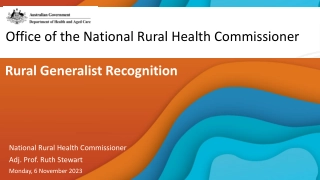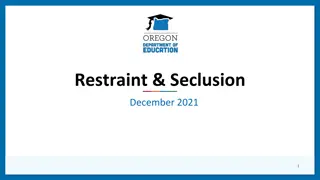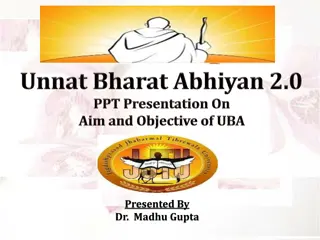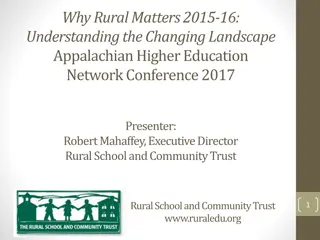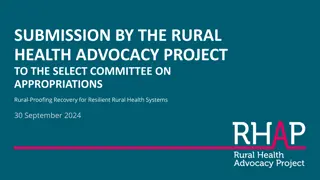Enhancing Rural Education: National Framework for Access, Equity, and Quality
The topic discusses the development and approval process of a National Framework for Rural Education aimed at enhancing access, equity, and quality in rural schools. It covers the background, purpose, presentation outline, and the steps taken towards final approval. The framework addresses pillars such as access, community mobilization, curriculum alignment, teacher development, and support for unique circumstances in rural schools.
Download Presentation

Please find below an Image/Link to download the presentation.
The content on the website is provided AS IS for your information and personal use only. It may not be sold, licensed, or shared on other websites without obtaining consent from the author.If you encounter any issues during the download, it is possible that the publisher has removed the file from their server.
You are allowed to download the files provided on this website for personal or commercial use, subject to the condition that they are used lawfully. All files are the property of their respective owners.
The content on the website is provided AS IS for your information and personal use only. It may not be sold, licensed, or shared on other websites without obtaining consent from the author.
E N D
Presentation Transcript
NATIONAL FRAMEWORK FOR RURAL EDUCATION: ENHANCING ACCESS, EQUITY AND QUALITY IN RURAL SCHOOLS Portfolio Committee Meeting DATE: 06 September 2022 DATE: 06 September 2022
PURPOSE To present to the Portfolio Committee Meeting a National Framework for Rural Education: Enhancing Access, Equity and Quality in Rural Schools for discussion. 2
PRESENTATION OUTLINE Purpose Background Towards a National Framework for Rural Education The National Framework For Rural Education: Enhancing Access, Equity and Quality in Rural Schools - Pillar 1: Access and Inclusivity - Pillar 2: Mobilising Rural Communities - Pillar 3: Harnessing Existing Curriculum to Better Respond to the Needs of Rural Communities - Pillar 4: Teacher Recruitment, Retention and Development - Pillar 5: Support to Schools in Unique Circumstances Roles and Responsibilities Response to the National Framework for Rural Education Conclusion 3
BACKGROUND On 11 March 2016, the Minister approved the appointment of the Research Team members to assist the sector with the development of a Rural Education Policy. The draft policy was presented for inputs from different structures within the sector. On 15 December 2017, the draft Rural Education Policy was gazetted for public comments. Several organisations submitted inputs on the policy. A recommendation was made by CEM to convert the Rural Education Policy into the Rural Education Framework. 4
TOWARDS A NATIONAL FRAMEWORK FOR RURAL EDUCATION SMM approved the draft policy in October 2017. HEDCOM approved the draft policy on 12 February 2018. On 11 May 2018, the draft policy was presented to CEM and a recommendation was made to reduce financial demands in the issue of small schools. On 7 August 2018, HEDCOM approved the revised draft policy. On 21 August 2018, the draft policy was presented at the Portfolio Committee meeting and was warmly welcomed and appreciated. On 11 November 2018, the draft policy was presented to CEM and a recommendation was made to take the draft policy back to provinces to make a recommendation that the policy be changed into a Framework. From February to March 2019, the Rural Education Directorate conducted consultative visits to all 9 provinces. The Draft Rural Education Framework was presented at the Inter-Provincial Rural Education Committee meeting held on 2-3 September 2021. The meeting recommended that the framework is ready to be presented to SMM, MMM, HEDCOM and CEM for approval. On 20 May 2022, the Draft Framework was presented at SMM and was approved for presentation at HEDCOM. On 6 June 2022, the Draft Framework was presented at HEDCOM and was approved for presentation at CEM. On 7 July 2022, the Draft Framework was presented to CEM and was approved. 5
Pillars of the National Framework for Rural Education The pillars of the National Framework for Rural Education are: Access and Inclusivity; Mobilising Rural Communities; Harnessing Existing Curriculum to Better Respond to the Needs of Rural Communities; Teacher Recruitment, Retention and Development; and Support to Schools in Unique Circumstances. 6
PILLAR 1: ACCESS AND INCLUSIVITY
ACCESS AND INCLUSIVITY DEFINING RURAL In South Africa rural refers to: Areas that consist of the tribal lands controlled by traditional leaders; Settings that are sparsely populated and where agriculture is the major means of economic activity; Areas of dense settlement created by colonial and apartheid-driven land settlements; and Mining areas in rural contexts where mining is no longer active. 8
ACCESS AND INCLUSIVITY CLASSIFYING RURAL SCHOOLS Overcoming rural school challenges requires a rigorous classification of rural schools so that specific interventions can target schools accurately. Such a classification can be informed by a set of indicators relating to school functioning and performance. These are: Location: public schools in rural areas may be situated on government land, communal land or private land (primarily on farms and on church land); School factors: School phase, teacher learner ratio, educational facilities such as available LTSM, libraries, laboratories and sports equipment, infrastructure and services; Cultural, social and economic factors; and Physical features: Transport, terrain and distance from services and facilities. 9
ACCESS AND INCLUSIVITY cont. EARLY CHILDHOOD DEVELOPMENT Facilities in primary schools should be expanded to absorb the young children going into Grade R. Appropriate resources, including qualified practitioners and material resources, should be made available for quality grade R programs. Where required, available infrastructure should be re-purposed for grade R intake, and where it is insufficient, additional infrastructure should be made provided. INCLUSIVE EDUCATION Specialised units should be established in the proposed Edu-villages that will provide specialised training for educators, including inclusive education. The DBE should strengthen the monitoring of the current inclusion model in Specialised, Special Needs and Full-Service Schools in rural contexts. 10
ACCESS AND INCLUSIVITY cont. INFORMATION COMMUNICATION TECHNOLOGY Edu-villages should serve as hubs from which various kinds of ICT related services and materials can be accessed by educators and learners. Advances in ICT should be leveraged in a manner that facilitates access for learners in rural schools. ICT should be incorporated into all facets of learning and teaching. INFRASTRUCTURE Physical infrastructure available in rural schools (classrooms, ablution facilities) should be of the standards as encapsulated in the Norms and Standards for Schools Infrastructure. Special infrastructure should be considered for sparsely populated areas. Additional infrastructure should be considered, where appropriate, to cope with the increase in intake due to the migration of ECD to Education. 11
PILLAR 2: MOBILISING RURAL COMMUNITIES
MOBILISING RURAL COMMUNITIES Enhancing community participation in educational affairs remains one of the key pillars for improving school functionality and the quality of education provision. The Framework proposes: Recruitment of Education Assistants (EAs) to provide support in curricular (Numeracy, Literacy, Reading), co-curricular (arts, sports, culture), and administrative activities; Expansion of the local pool of educators by offering training to EAs so that they can enter the teaching profession; Mobilising the school community in development initiatives (environmentally specific: agriculture, mining, fishing, wildlife management, nutrition); Mobilising elders to share cultural and natural heritage of the community (history, arts and culture, language); Mobilising communities to participate in activities that enhance inclusive practices; and The establishment of partnerships between the school and local community (businesses, local government, service providers, faith-based organisations, traditional councils) to support teaching, learning and wellbeing. 13
PILLAR 3: HARNESSING EXISTING CURRICULUM TO BETTER RESPOND TO THE NEEDS OF RURAL COMMUNITIES
HARNESSING EXISTING CURRICULUM TO BETTER RESPOND TO THE NEEDS OF RURAL COMMUNITIES AGRICULTURE EDUCATION FOR ALL Agricultural education can play a crucial role in economic development in general and rural socio-economic development in particular. Formalising agriculture as a teaching subject throughout the system; Expanding focus schools for agriculture that offer all Agricultural Education Subjects. Consideration should be made to having at least one Agricultural school in each district; Funding should be ring-fenced for Agriculture; and Ensure that there are qualified Agriculture educators to enable the expansion of Agricultural Education. 15
HARNESSING EXISTING CURRICULUM TO BETTER RESPOND TO THE NEEDS OF RURAL COMMUNITIES cont. ENHANCEMENT OF THE TEACHING OF ARTS, CULTURE AND SPORTS Arts, Culture and Sports are important for the holistic development of youth, their well-being, and potentially significant contributors to rural economic development. The Framework proposes strengthening the teaching of these subjects, which will: Require placing value on indigenous activities and resources that are inherent to rural spaces. It is proposed that: Focus schools for Arts, Culture and Sports should be expanded in rural areas; Technological advances should be leveraged to enhance curriculum implementation in these subjects; Investments are required in appropriate LTSM, for the teaching of these subjects, together with teacher training; Schools should be encouraged to draw on knowledge available in communities (amongst elders) to enhance learning and teaching; and Indigenous Arts, games and sports should be encouraged as a way of enhancing teaching of these subjects. 16
HARNESSING EXISTING CURRICULUM TO BETTER RESPOND TO THE NEEDS OF RURAL COMMUNITIES cont. READING, NUMERACY/MATHS AND LITERACY/LANGUAGES Numeracy/ Mathematics and Literacy/ Languages are the cornerstones for future employability and further studies. The Framework proposes the strengthening of these skills in rural schools through: Initiating projects that aim to increase the Numeracy and Literacy skills of learners in rural schools; Making available the necessary Learning and Teaching Support Materials to enhance the development of basic skills in these subjects; and Deploying Education Assistants to facilitate Reading and Maths Clubs. 17
PILLAR 4: TEACHER RECRUITMENT, RETENTION AND DEVELOPMENT
TEACHER RECRUITMENT, RETENTION AND DEVELOPMENT It is difficult to recruit, retain and develop qualified teachers in a rural setting due to distances of schools from towns, poor infrastructure and limited service delivery. To address these challenges, the Framework proposes: Creating a package of teacher incentives that goes beyond finance and includes teacher development, career progression, transport, accommodation, recreation and other essential services; Establishing Edu-villages with the intention of providing accommodation for teachers. These Edu-villages should also serve as hubs for teacher development activities; Recruitment and appointment of Education Assistants to provide support to teachers as a way of enhancing teacher well-being; and Opportunities should be created for Education Assistants to access Initial Teacher Education through school-based teacher education programmes using various modes (distance, online and block release for face-to-face sessions). 19
PILLAR 5: SUPPORT TO SCHOOLS IN UNIQUE CIRCUMSTANCES
SUPPORT TO SCHOOLS IN UNIQUE CIRCUMSTANCES Schools with unique circumstances include: Small primary and secondary schools which are the only means of access to education in some communities; and Schools that struggle to recruit and retain teachers in scarce subjects. The Framework recommends: A minimum number of teachers to be determined for primary and secondary schools; The appointment and deployment of itinerant teams of educators and specialists to work with clusters of schools in scarce subjects; and The use of Education Assistants to provide support to teachers in these schools. 21
ROLES AND RESPONSIBILITIES
NATIONAL LEVEL The DBE is responsible for setting guidelines; developing strategies; monitoring and evaluating the implementation of the policy; and ensuring that resources required for the implementation of the policy are available. o Establishment of the Rural Education Advisory Committee to advise the Minister on the implementation of the rural education policy; funding rural education programmes; and monitoring and evaluating the impact of policies on rural schools; o Establishment of Inter-departmental Collaborations to strengthen the support and the delivery of quality education in rural schools; o Establishment of a National Team of key heads of branches that meets to plan, implement and account for the ways in which their branches respond to this rural education policy mandate; and report on other programmes and initiatives that target rural schools; and o Establishment of an Inter-provincial Rural Education Committee that comprises officials responsible for rural education from all provinces. This committee will be responsible for the coordination and reporting on activities to support rural schools in providing quality education. 23
PROVINCIAL LEVEL Establishment of a dedicated Directorate or Sub-directorate (guided by the number of rural schools) for rural education. Establishment of a Provincial Rural Education Committee that interpret national policies, prepare implementation plans and coordinate the activities embracing rural education across their province. Prepare plans for implementation at individual and school cluster level and plan the placement of Edu-villages and teacher development centres. Secure the required financial, material and human resources to implement the policy. Monitor and evaluate the implementation of the rural education policy. 24
DISTRICT LEVEL Establish Committee to oversee and monitor the implementation process and to support the schools in rural areas. To strengthen this Committee: Allocate a dedicated person responsible for rural education in all districts; and Facilitate the training of SGBs in specialised functions arising from the policy. a District Rural Education 30
SCHOOL LEVEL The SGB s responsibilities include: Mobilising the community to enhance the participation of the community and various stakeholders in school development; and Identifying and harnessing (cultural, natural, material, social) to support teaching and learning. broader school resources 26
RESPONSE TO THE NATIONAL FRAMEWORK FOR RURAL EDUCATION
MOBILISING RURAL COMMUNITIES RURAL EDUCATION ASSISTANTS PROJECT (REAP) Participation of rural communities has been a central pillar of this project Between 2018 and 2021, DBE implemented the Rural Education Assistants Project (REAP) which aimed to: Pilot the use of Education Assistants (EA s) to improve the quality of education in rural schools To provide enhance livelihoods for unemployed youth in rural communities To Develop a Framework for Education Assistants. The REAP involved 188 primary schools in KZN, LP and EC, employing more than 900 youth from rural communities. EAs in schools not only assisted in curricular and extra-curricular activities for teachers but also significantly contributed to teacher well-being, as well as contributed to reduction of youth unemployment and thereby contributed to livelihoods in communities. 28
HARNESSING EXISTING CURRICULUM TO BETTER RESPOND TO THE NEEDS OF RURAL COMMUNITIES REAP - AGRICULTURE EDUCATION PROJECT The DBE has developed a concept document on Agricultural Education which guided its implementation of a self sufficient agricultural schools model through the REAP. An Agricultural high school in Limpopo (Mandela Barloworld) was supplied with resources (Green House, Piggery, Fencing, Borehole, Layers house) and equipment (dehorning, artificial insemination, castrating tools) as part of turning the school into a self sufficient Agricultural School. The aim of the provision of these resources was for the school to partner with the five primary schools in the surrounding area to implement agricultural projects. DBE has embarked on expanding Agriculture Focus Schools in provinces, and progress is being reported through the Inter Provincial Rural Education Committee meetings. 29
HARNESSING EXISTING CURRICULUM TO BETTER RESPOND TO THE NEEDS OF RURAL COMMUNITIES ENABLING RURAL SCHOOLS PROJECT (ERSP) The purpose of the project is to conduct research on how schools work effectively with families and communities in rural areas to improve and sustain young children's learning, health and wellbeing of their schooling. The Project is implemented in 10 pilot schools in the North West province and has employed 50 young people as Reading Champions and 4 as Field workers It focuses on: the Foundation Phase of primary schooling (children aged 6-9); The central role of school leadership together with the pivotal Foundation Phase in education; and Foregrounds reading for joy as essential building block to promote quality education, achievement and progress. The ERSP in the North West is supporting the development and use of locally produced LTSM through the development of materials in the local (Setswana) language. 30
ACCESS AND INCLUSIVITY: ICT EDULUTION PROJECT DBE is piloting Edulution Project in KZN and Mpumalanga. Edulution utilises Technology to deliver NCS-aligned Maths content to learners in grades 4 6 in the rural primary schools. The project aims to: - improve the educational outcomes for learners who participate in the programme through regular testing and tracking individual progress and results; and - reduce unemployment and promote enterprise development in rural communities by providing jobs for previously unemployed youth who serve as coaches and facilitate Edulution sessions. 24 centres have been opened in the provinces (13 in KZN and 11 in MP) 31
ACCESS AND INCLUSIVITY: ICT cont. 65 Young people have been employed as coaches to facilitate the Edulution Sessions for grades 4 6 learners A total of 6911 learners are benefitting from the pilot Existing infrastructure has been repurposed to deliver the programme. The Edulution project has provided ICT equipment (tablets) to learners to facilitate the development of Numeracy skills in the Intermediate Phase (KZN and MP) as part of leveraging the use of ICT to support learning and teaching. The Edulution Programme has provided about 1150 tablets to grade 4 6 learners in 24 centres These tablets are pre-loaded with the CAPS-aligned content to facilitate the Mathematics catch-up sessions for learners in the centres 32
PARTNERSHIPS RURAL YOUTH EMPLOYMENT OPPORTUNITIES All projects implemented by the Rural Education Directorate have created opportunities for rural youth employment for improving Numeracy/Maths and Literacy/Reading. - REAP: Employed 900 young people to work as Education Assistants. - Edulution: Employed ------ to work as coaches . - ERSP: employed 60 young people to work as Community Reading Champions. PUBLIC PRIVATE PARTNERSHIPS Edulution is a partnership project between DBE and Se ego Foundation. Education Partnerships Group (EPG): This is an emergent partnership between DBE and EPG to deliver school accountability project in LP and MP. Enabling Rural Schools Project (ERSP): This is a partnership between DBE and the University of Pretoria and University College London to implement a Literacy improvement project in Foundation phase in the NW province. 33
CONCLUSION The National Rural Education Framework aims to ensure that rural schools provide quality education for all learners, in line with the democratic principles of the Constitution as well as the vision of the NDP. This requires overcoming many challenges of concern to the macro environment as well as school level disparities across the public school system. 34


